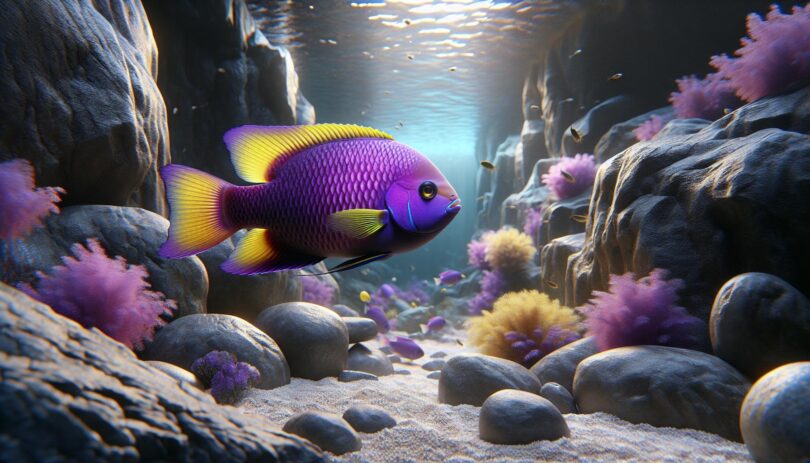Caring for electric catfish might seem like a challenge reserved for seasoned aquarists, but it’s actually more manageable than you might think. These fascinating fish, known for their ability to generate an electric charge, can make an exciting addition to your home aquarium—pun intended.
Understanding the essentials of their care is crucial to ensuring they thrive. From selecting the right tank size and maintaining proper water parameters to providing a suitable diet, I’ll walk you through everything you need to know. For those looking to mix a bit of thrill with their hobby, much like the excitement found at Kasinonero, let’s explore the electrifying world of electric catfish care together.
Choosing the Right Tank Size
When diving into the world of aquarium setup for electric catfish, one of the first things I had to consider was the aquarium tank size. It’s crucial to understand that while these freshwater fish might start small, they can grow significantly. So, selecting the appropriate tank size from the get-go is essential to ensure their comfort and health over time.
For a single electric catfish, I’d recommend a minimum tank size of 75 gallons. This size allows them enough space to swim freely and exhibit natural behaviors. However, if you’re planning on creating a community tank, you’ll need to increase the size accordingly to accommodate the additional fish profiles you intend to include. Remember, more fish means a need for more space to prevent stress and aggression among your aquatic pets.
Aside from the tank’s capacity, it’s paramount to equip your aquarium with the right aquarium equipment. This includes a fish tank filter to keep the water clean and a water conditioner for fish tank to maintain the optimal water parameters. Electric catfish thrive in well-maintained environments, so ensuring the water is in pristine condition is a non-negotiable aspect of their care.
Moreover, investing in a reliable aquarium heater is critical, especially if you live in a region with fluctuating temperatures. Electric catfish require a stable environment to flourish, making the temperature control provided by an aquarium heater indispensable.
Lastly, while not directly related to tank size, don’t overlook the importance of proper aquarium light. Lighting not only highlights the beauty of your electric catfish but also supports any live plants you might have in the aquarium. However, it’s key to balance the lighting to meet the needs of both your plants and fish, ensuring a harmonious aquatic ecosystem.
In my journey, understanding the starting your aquarium essentials, particularly in choosing the right tank size and equipping it with necessary accessories, has made a world of difference in the wellbeing of my electric catfish.
Creating the Ideal Habitat
When setting up the perfect home for electric catfish, my experience has shown me that understanding their natural environment is key. These unique freshwater fish thrive in environments that mimic their native African rivers. So, when starting your aquarium, focusing on recreating these conditions is crucial for their health and happiness.
First off, choosing the right aquarium tank size is foundational. As mentioned, a minimum of 75 gallons is necessary for a single electric catfish. This assures they’ve got plenty of room to explore. When adding more fish or creating a community tank, scaling up this size is essential. Remember, more space means happier fish.
Next, aquarium equipment plays a significant role in setting up their habitat. A robust fish tank filter is non-negotiable. Electric catfish produce a good amount of waste, and maintaining pristine water conditions is imperative. Combining mechanical, chemical, and biological filtration ensures a clean tank and healthy fish.
The aquarium light should mimic natural light cycles, promoting a regular day and night rhythm for your catfish. This is not just for aesthetics; it helps regulate their biological clock.
Temperature is another critical factor. Using an aquarium heater, keep the water temperature consistent, ideally between 75°F and 82°F. Sudden temperature shifts can stress these sensitive creatures, so stability is key.
Lastly, the introduction of a water conditioner for the fish tank is a step I never skip. Tap water can contain harmful chemicals that are toxic to your fish. A quality water conditioner neutralizes these threats, ensuring a safe environment.
By focusing on these specific aspects, creating an ideal habitat for electric catfish isn’t just a possibility—it’s a guarantee. Keeping these guidelines in mind ensures that you’re well on your way to providing a nurturing and stimulating environment for your aquatic friends.
Maintaining Water Parameters
When I’m setting up a home for my electric catfish, keeping tabs on the water parameters tops my list of priorities. It’s not just about filling the tank and hoping for the best. Water quality is paramount for the health and happiness of these freshwater fish. Knowing the right parameters and how to maintain them can make all the difference.
First off, let’s talk about temperature. Electric catfish thrive in water temperatures between 72 to 82°F (22 to 28°C). This means an aquarium heater isn’t just an optional accessory; it’s a necessity. Keeping the tank within this range ensures that my electric catfish remain active and healthy. But, it’s not all about heat. Stability is key. Sudden temperature fluctuations can stress them out, leading to health issues down the line.
Next up, the pH level, which should be maintained at 6.5 to 7.5. This slightly acidic to neutral range mimics their natural African river habitats. To keep everything in check, I always have a pH testing kit on hand. It’s a simple tool, but it plays a crucial role in monitoring the health of the aquatic environment.
Water hardness is another factor to consider. Aim for a general hardness (GH) of 8-12 dGH. It might seem like a minor detail, but getting it right can influence the overall well-being of the fish.
Lastly, nitrate levels should be kept low, below 20 ppm, to prevent harmful effects. This is where a robust fish tank filter becomes indispensable. It’s not just about clearing out visible debris; it’s about maintaining an invisible balance. A high-quality filter, alongside regular partial water changes, helps control nitrate levels, ensuring a healthy environment for the electric catfish.
Incorporating a water conditioner for the fish tank is also a smart move. It neutralizes harmful chemicals in tap water, making it safe for my aquatic friends. Starting your aquarium with these parameters in mind sets a strong foundation for a thriving electric catfish habitat.
Feeding Your Electric Catfish
When it comes to the diet of electric catfish, I’ve found that variety is key. These fascinating creatures are not picky eaters, but they do require a balanced diet to ensure their health and longevity. In my experience, a mix of live, frozen, and dry foods will keep your electric catfish both happy and healthy.
For starters, live foods like bloodworms, brine shrimp, and small fish can be a great way to mimic their natural hunting instincts. It’s thrilling to watch an electric catfish hunt, and it’s also beneficial for their well-being. However, relying solely on live food isn’t practical for everyone, so supplementing with high-quality frozen foods is a great alternative.
Dry foods, specifically those designed for bottom feeders, can also be a part of their diet. Make sure these foods are of good quality and sink to the bottom of the tank, where your electric catfish spends most of its time. It’s essential to read fish profiles when selecting these foods to ensure they meet the nutritional needs of your electric catfish.
Another critical aspect of feeding your electric catfish involves aquarium setup considerations, especially the size of your tank. These fish can grow quite large, and ensuring they have ample space is crucial not just for their physical health but also for maintaining water quality. A spacious aquarium allows for more stable water parameters, which in turn affects the efficacy of your fish tank filter and overall aquarium health.
Remember, overfeeding is a common mistake that can lead to poor water quality. It’s imperative to use a combination of aquarium equipment like filters and water conditioners for fish tanks to maintain a clean and healthy environment. Regular monitoring and vacuuming of the substrate will help remove any uneaten food and prevent the buildup of harmful substances.
Incorporating these feeding practices and considerations into your routine will significantly contribute to the well-being of your electric catfish, ensuring they thrive in their aquatic home.
Handling and Safety Guidelines
Handling electric catfish requires caution and understanding. Unlike most freshwater fish, electric catfish possess the unique ability to generate and discharge electric shocks. These shocks are primarily a defense mechanism and not intended to harm intentionally. However, when it comes to aquarium equipment maintenance or moving these intriguing creatures, it’s essential to be fully aware of the risks involved.
First, always ensure that the aquarium tank size is appropriate for the size and number of electric catfish you’re keeping. A cramped space can stress the fish, making them more prone to discharging shocks. Secondly, when performing tasks such as aquarium setup changes, aquarium light adjustments, or water conditioner for fish tank additions, it’s advisable to turn off or unplug any electrical devices that are not waterproof to avoid accidents.
For safe handling, I recommend using non-conductive tools. Rubber gloves can provide a measure of protection, though they may not fully insulate against a strong discharge. It’s also wise never to attempt to hold or move electric catfish with your bare hands. Instead, use a plastic container to gently guide them if necessary.
Another key aspect of safety is regular maintenance of your fish tank filter and doing partial water changes. This not only keeps your electric catfish healthy but also reduces the risk of unplanned shocks during hands-on tank management.
Understanding that electric catfish pose no real threat when treated with respect and caution will enhance your experience as an aquarist. By adhering to these safety tips, you’re ensuring not only your well-being but also that of your electric catfish, enabling them to thrive in their aquatic home.
Conclusion
Caring for electric catfish can be a rewarding experience if you’re well-prepared and informed. Remember, maintaining the right water parameters is crucial for their health. A balanced diet that mirrors their natural feeding habits will ensure they thrive under your care. Don’t forget the importance of tank size and the need for regular maintenance to keep your aquatic friends happy and safe. Handling them requires caution due to their unique defense mechanism, but with the right precautions, you’ll find it’s entirely manageable. Dive into the world of electric catfish care with confidence, and you’ll be rewarded with the fascinating behavior and unique presence of these electrifying creatures in your aquarium.




